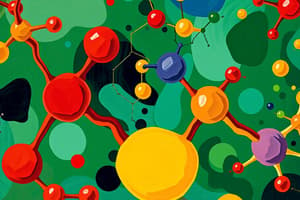Podcast
Questions and Answers
Na+ and K+ ions are electrolytes. Therefore, they dissolve......................in water.
Na+ and K+ ions are electrolytes. Therefore, they dissolve......................in water.
and dissociate
Name the macromolecule made up by nucleotides, sugars, and amino acids.
Name the macromolecule made up by nucleotides, sugars, and amino acids.
- Nucleic Acid (correct)
- Carbohydrates (correct)
- Proteins (correct)
- All of the above
The amount of which subatomic particle is different between an atom and its ion?
The amount of which subatomic particle is different between an atom and its ion?
Electrons
What are lipids?
What are lipids?
Select all that are functions of proteins:
Select all that are functions of proteins:
A polar bond is created when?
A polar bond is created when?
What type of organic molecule comprises the majority of a potato?
What type of organic molecule comprises the majority of a potato?
As a result of the electron configuration of a water molecule, water is a great A.)................because water can break up and surround a B.).................as long as it is C.)................
As a result of the electron configuration of a water molecule, water is a great A.)................because water can break up and surround a B.).................as long as it is C.)................
The.............region of an amphipathic molecule is attracted to water.
The.............region of an amphipathic molecule is attracted to water.
Globular and fibrous shapes are created with..................structure of proteins caused by further folding due to disulfide bridges, hydrophobicity, and Van der Waals forces.
Globular and fibrous shapes are created with..................structure of proteins caused by further folding due to disulfide bridges, hydrophobicity, and Van der Waals forces.
Are lipids polymers?
Are lipids polymers?
Are lipids insoluble?
Are lipids insoluble?
Lipids function as stored:
Lipids function as stored:
The most common form of lipids are:
The most common form of lipids are:
What is the primary structure of a protein?
What is the primary structure of a protein?
What is the secondary structure of protein?
What is the secondary structure of protein?
What is the tertiary protein structure?
What is the tertiary protein structure?
What is quaternary structure?
What is quaternary structure?
Amino acids are made up of a (+) charged A.)..............group, a (-) charged B.).....................group, and a side chain.
Amino acids are made up of a (+) charged A.)..............group, a (-) charged B.).....................group, and a side chain.
Study Notes
Electrolytes and Solutions
- Na+ and K+ ions act as electrolytes, dissolving and dissociating in water.
Macromolecules and Monomers
- Nucleotides form Nucleic Acids.
- Sugars are the building blocks of Carbohydrates.
- Amino acids are the monomers for Proteins.
Atomic Structure
- The distinguishing factor between an atom and its ion is the number of electrons.
Lipids
- Lipids are essential components of cell membranes.
- They do not form polymers and are insoluble in water.
- Main form of lipids are triglycerides, serving as stored nutrients.
Protein Functions
- Proteins primarily facilitate movement and transport nutrients, not serving as an energy source or storage for genetic information.
Polar Bonds
- A polar bond arises when atoms in a bond exert unequal forces on shared electrons, causing electron distribution to favor one atom.
Organic Molecules
- Polysaccharides make up the majority of a potato.
Properties of Water
- Water acts as an effective solvent, breaking up and surrounding solutes that are nonpolar.
Amphipathic Molecules
- The polar region of an amphipathic molecule is hydrophilic and attracted to water.
Protein Structure
- Tertiary structure involves the three-dimensional shape of proteins, influenced by disulfide bridges, hydrophobic interactions, and Van der Waals forces.
- Primary structure is defined by the sequence of amino acids linked by covalent peptide bonds.
- Secondary structure can form alpha helices or beta-pleated sheets, providing flexibility.
- Quaternary structure involves multiple polypeptides forming a functional unit, exemplified by hemoglobin.
Amino Acids Composition
- Amino acids consist of a positively charged amino group, a negatively charged carboxyl group, and a variable side chain.
Studying That Suits You
Use AI to generate personalized quizzes and flashcards to suit your learning preferences.
Description
Test your knowledge of fundamental chemistry concepts with these flashcards from Anatomy & Physiology Chapter 2. Focus on key topics such as electrolytes, macromolecules, and subatomic particles. Perfect for reviewing essential terms and definitions in preparation for your exam.




